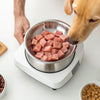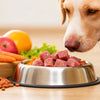How to Prepare Raw Food for Your Dog: A Comprehensive Guide
- Houndsy
Table of Contents
- Introduction
- Understanding the Benefits of a Raw Food Diet
- Nutritional Foundations of Raw Dog Food
- Step-by-Step Guide to Preparing Raw Food
- Food Safety Considerations
- Customizing Your Dog’s Raw Diet
- Exploring Popular Raw Diet Models
- Conclusion
Introduction
Imagine this: a vibrant, happy dog with a shiny coat, healthy teeth, and boundless energy bounding towards you. What if we told you that the secret to this vitality lies not in a fancy bag of kibble but in the rich, nourishing ingredients of a raw food diet? As more pet parents seek to ensure their furry companions thrive, the question naturally arises: how to prepare raw food for your dog?
The significance of this topic cannot be overstated. Research indicates that a raw food diet can enhance digestion, improve skin and coat condition, and increase overall energy levels in dogs. However, many dog owners feel overwhelmed by the prospect of switching from commercial dog food to raw. By breaking down the process into manageable steps, we aim to empower you to join the ranks of devoted pet parents who prepare fresh, wholesome meals for their dogs.
In this blog post, we will share everything you need to know about preparing raw food for your dog, including the nutritional requirements, practical tips, step-by-step preparation guides, and essential safety measures. By the end, you’ll have the knowledge and confidence to embark on this rewarding journey.
Understanding the Benefits of a Raw Food Diet
Before diving into the practicalities of preparation, let’s take a moment to explore why transitioning to a raw food diet may be beneficial for your dog.
Health Improvements
Numerous studies suggest that dogs on a raw food diet can experience:
- Enhanced Digestion: Raw diets can lead to smaller, firmer stools, indicating better nutrient absorption.
- Healthier Skin and Coat: Many dog owners report shinier fur and reduced skin issues after switching to raw food.
- Improved Energy Levels: Dogs often become more active and playful when fed a diet rich in whole, unprocessed ingredients.
- Reduced Allergies: A carefully controlled raw diet can mitigate allergenic reactions and intolerances.
Nutritional Superiority
Dogs are naturally carnivorous, with a digestive system designed to process raw meat and bones efficiently. A raw food diet typically includes muscle meat, organ meats, and bones, closely mimicking what their ancestors would eat in the wild.
Control and Customization
By preparing raw food yourself, you gain control over your dog's diet, allowing you to tailor meals to suit specific health needs, dietary restrictions, or preferences. This level of customization is difficult to achieve with pre-packaged dog foods.
Nutritional Foundations of Raw Dog Food
To create a well-balanced diet for your dog, understanding the pivotal components is crucial. Here’s a brief overview of what a balanced raw dog food diet should consist of:
Protein Sources
A dog's diet should primarily consist of high-quality proteins:
- Muscle Meat: Beef, chicken, turkey, lamb, and pork are all excellent sources.
- Organ Meats: Liver, kidneys, and hearts are nutrient-dense and critical for overall health.
- Bones: Raw bones provide important nutrients and help with dental health.
Vegetables and Fruits
While dogs do not necessarily require plant-based foods, incorporating small amounts can enhance their meals:
- Vegetables: Carrots, spinach, and broccoli are great for adding fiber and nutrients.
- Fruits: Apples and blueberries can offer vitamins and antioxidants, but should be given in moderation.
Supplementary Ingredients
Occasionally, you might consider adding supplements:
- Fish Oil: Rich in Omega-3 fatty acids for healthy skin and joints.
- Calcium: If not using bones, consider adding ground eggshells or a calcium supplement to ensure healthy bone formation.
Step-by-Step Guide to Preparing Raw Food
Now that we've established the importance of the right ingredients and nutritional balance, let’s dive into the practical steps of preparing raw food at home.
Ingredients You'll Need
- Protein Sources: Choose lean meats like ground beef, chicken necks, turkey, or lamb.
- Vegetables: Fresh carrots, spinach, or greens, ideally pureed for better digestion.
- Fruits: Small amounts of fruits like apples or blueberries.
- Supplements: Fish oil and calcium (if needed).
- Equipment: A large mixing bowl, food processor (for vegetables), storage containers, and gloves for hygiene.
Step 1: Choose Your Proteins
Determining your protein sources is the first step. A general rule of thumb for balance is to comprise about 70% protein (a mix of muscle and organ meats), with the remaining 30% made up of vegetables and supplements.
Step 2: Prepare the Ingredients
- Chop Proteins: Cut the muscle meat into bite-sized pieces for easier mixing.
- Prepare Organs: If using whole organ meats, make sure they are fresh, and chop them into manageable pieces.
- Process Vegetables: Use a food processor to puree vegetables, which aids in better absorption by your dog.
Step 3: Mix the Ingredients
In a large mixing bowl, combine the chopped meats and pureed vegetables. Strive for the following proportions:
- 70% Muscle Meat
- 10% Organ Meat
- 10% Raw Bones
- 10% Vegetables/Fruits
Step 4: Portion and Store
You can divide the mixture into meal-sized servings, placing them in airtight containers. Label them with the date and type of ingredients used, and store portions in your freezer for later use.
Step 5: Thaw Before Serving
When ready to feed your pup, thaw the food overnight in the refrigerator to keep it fresh and safe.
Food Safety Considerations
Handling raw meat requires care, as contamination can lead to health issues for both pets and owners. Here are some safety tips:
- Hygiene: Wash hands and surfaces thoroughly after contact with raw meat. Use separate cutting boards designated only for pet food preparation.
- Avoid Cross-Contamination: Do not mix raw dog food with human food or prepare it in the same area where human food is prepared.
- Proper Storage: Always freeze or refrigerate raw food promptly to prevent bacterial growth.
Customizing Your Dog’s Raw Diet
Each dog is unique, and customizing a raw diet ensures that their specific needs are met. Here are some key factors to consider:
Age and Activity Level
- Puppies: Require more calories and nutrient-dense foods to support growth.
- Active Dogs: May need higher protein and calorie levels to maintain energy.
- Seniors: Might benefit from softer proteins and tailored nutritional content to aid digestion.
Health Conditions
If your dog has health concerns, adjusting their diet can be crucial. For example, dogs with sensitive stomachs may need easily digestible proteins, while overweight dogs might benefit from lower-fat protein sources.
Exploring Popular Raw Diet Models
Understanding various raw feeding models can also guide you in meal preparation:
BARF Diet (Biologically Appropriate Raw Food)
The BARF diet emphasizes feeding primarily raw muscle meat, bones, and a small percentage of fruits and vegetables. The typical formula is:
- 70% uncooked muscle meat
- 10% raw edible bone
- 10% organ meats
- 10% fruits and vegetables
Prey Model Diet
This model replicates what dogs would eat in the wild, consisting mainly of whole prey animals, ensuring a natural balance of nutrients.
Whole Prey Model
While not strictly necessary for all dogs, this model emphasizes using raw muscle meat and bones without the inclusion of plant materials, ideal for dogs with allergies.
Conclusion
Learning how to prepare raw food for your dog creates an excellent opportunity to enhance their health and well-being. With the right ingredients, preparation techniques, and careful attention to dietary balance, you can establish a delicious and nutritious meal plan that caters to your dog’s individual needs.
As you embark on this fulfilling journey, remember that it’s not just about the food; it’s about nurturing your bond as a pet parent. With every meal, you’re not only fueling their body but also investing in their happiness and vitality.
If you’re considering an ongoing need for convenient and aesthetically pleasing dog feeding options, we invite you to explore the Houndsy Kibble Dispenser. Designed with a commitment to convenience and style, our dispenser allows you to effortlessly manage your dog’s meals while complementing your home décor.
FAQ
1. How do I know if my dog needs a raw diet?
- Consider your dog’s health, age, activity levels, and sensitivities. Many dog owners report health improvements after transitioning to raw, but it’s advisable to consult your veterinarian before making changes.
2. Can I feed my dog raw vegetables?
- Yes! Dogs can often benefit from small amounts of pureed or chopped vegetables, which can add fiber and nutrients to their diets.
3. What if my dog refuses to eat raw food?
- Transitioning diets can take time. Begin slowly by mixing raw with their current food, gradually increasing the proportion of raw.
4. How often should I feed my dog raw food?
- Typically, adult dogs should be fed once or twice a day, while puppies may require more frequent feeding throughout the day.
5. Are there any risks associated with raw feeding?
- While raw diets can offer several benefits, there are risks such as bacterial contamination. Proper handling and food safety practices are essential to minimize these risks. Always consult with a vet if unsure.












